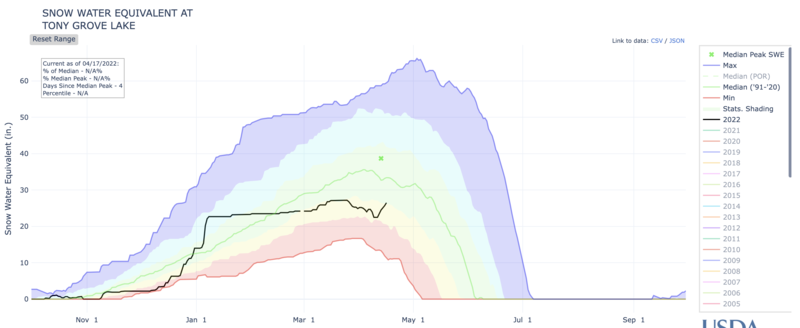Forecast for the Logan Area Mountains

Issued by Paige Pagnucco on
Sunday morning, April 17, 2022
Sunday morning, April 17, 2022
The avalanche danger is CONSIDERABLE today and human-triggered avalanches are likely on steep, upper elevation slopes where areas of unstable wind-drifted snow exist. Warm temperatures will increase the likelihood of wet avalanches.
Dangerous avalanche conditions exist and careful snowpack evaluation, cautious route-finding, and conservative decision-making are essential today. Your best bet for safe travel will be on sheltered slopes less than 30 degrees.

Low
Moderate
Considerable
High
Extreme
Learn how to read the forecast here
 Special Announcements
Special Announcements
Today is our last regular avalanche forecast but we will continue posting observations and avalanches. Thanks for a great season!
 Weather and Snow
Weather and Snow
The 8400' Tony Grove Snotel reports 25°F this morning, and there is 71 inches of total snow at the site, containing 77% of normal SWE. Westerly winds are currently blowing around 18 mph at the 9700' CSI Logan Peak weather station with gusts in the 20's. The mountains picked up a few more inches of snow overnight.
This week's powder riding conditions are a thing of the past as seasonal temperatures took their toll yesterday. Today the snow surface will likely either be damp or refrozen with a dusting of new snow.
Today there is a 20% chance of snow showers before noon. Afternoon skies will be partly cloudy, temperatures will be near 36 and westerly winds will blow 18 to 21 mph, with gusts as high as 32 mph. Tonight will be partly cloudy, with a low around 23 with west winds bowing 11 to 18 mph becoming south after midnight. Monday expect sunny skies, temperatures near 51, and south-southwest winds blowing 13 to 21 mph, with gusts as high as 32 mph.

In addition to providing a few bonus powder days, this past week's wet weather (4.9" SWE total since Monday) moved us a bit closer to the average for the season.
 Recent Avalanches
Recent Avalanches
Multiple soft slab and wind slab, natural and human-triggered avalanches were reported Friday and Saturday. All occurred above 9000' on NE through E-facing slopes and ranged in width from 100' to 1000' wide.

This snowmobile-triggered avalanche in White Pine Canyon was 2' deep and 1000' wide. (PC: Hawley)

This natural wind slab avalanche, reported Saturday, occurred at 9200' on a NE-facing slope. (PC: Choi)
Check out all the recent backcountry observations and avalanche reports from across Utah HERE.
Avalanche Problem #1
Wind Drifted Snow
Type
Location

Likelihood
Size
Description
Sustained winds have created sensitive areas of wind drifted snow. These drifts mainly exist on north and east facing slopes but can develop on all aspects with erratic mountain winds.
Avoid steep slopes with freshly wind-drifted snow as well as areas like sub-ridges, scoops, and other terrain features where sensitive drifts of snow can form. Many of the recent avalanches occurred under cliff bands, on steep rollovers, and just below ridgelines. Much firmer snow underfoot is a good clue you're on a wind slab as well as a hollow, drum-like feel. Watch for shooting cracks - a sure sign of instability.
Sheltered slopes less than 30 degrees will be your best bet for safe travel.
Avalanche Problem #2
Wet Snow
Type
Location

Likelihood
Size
Description
It's mid-April and the possibility exists of triggering a loose wet or wet slab avalanche. The high sun angle can quickly warm and soften the snow creating unstable conditions. With today's temperatures, wet avalanches may not be much of a problem but they will for sure be tomorrow with mountain temperatures nearing 50 F.
Watch for signs of instability like rollerballs and pinwheels. When the snow surface becomes damp or saturated, it's time to move to lower-angle terrain or perhaps call it a day.
Additional Information
- Always follow safe backcountry travel protocols. Go one person at a time in avalanche terrain, while the rest of your party watches from a safe area. (practice anytime while traveling on or under backcountry slopes steeper than 30°)
- Check your avalanche rescue equipment, change your batteries, and practice often with your backcountry partners.
Check slope angles, and to avoid avalanche terrain stay off of and out from under slopes steeper than 30° and adjacent slopes. Video Here
General Announcements
Special thank you to Polaris and Northstar...Video Here
Who's up for some free avalanche training? Get a refresher, become better prepared for an upcoming avalanche class, or just boost your skills. Go to https://learn.kbyg.org/ and scroll down to Step 2 for a series of interactive online avalanche courses produced by the UAC.
- Please submit your observations from the backcountry HERE.
This information does not apply to developed ski areas or highways where avalanche control is normally done. This forecast is from the U.S.D.A. Forest Service, which is solely responsible for its content. This forecast describes general avalanche conditions and local variations always occur.




